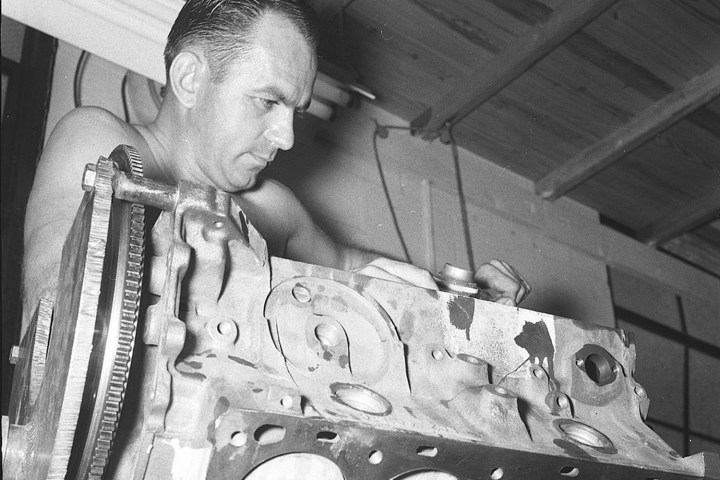
Disclaimer: This article contains engineering speak
The engine in your car right now is terrible at its job.
Your motor only has to do one thing: convert gasoline into mechanical energy by burning it. It does this several times a second when it is running — and it does so very poorly. Burning gas creates heat. That heat, in the form of a rapid explosion, is what powers your car’s wheels (with a few parts and steps in between). Therefore, your engine should capture as much of that heat (explosion) as possible. But the engine in your car likely only captures a measly 20-30% of the heat it produces. This number is called “thermal efficiency” if you went to school for a long time, and in 1975 the U.S. Army tested a truck that got up to 48% thermal efficiency using an “adiabatic engine.” This crazy sounding engine also promised more horsepower while also increasing efficiency. So where does this engine come from, and why aren’t we using it today?

The concept of adiabatic is as old as automotive engineering (BTW it’s pronounced “aid-ee-a-bad-ik”), and simply means a system where heat cannot enter or leave. If heat is trapped inside, it’s adiabatic. So why would you try trapping the heat inside an engine, when about a third of the typical engine bay is dedicated to purging heat through radiators and coolant flows? You theoretically want heat to vaporize your gasoline. As you may know, liquid gasoline doesn’t actually burn all that well – it’s the vapor on top of a pool of gas that actually burns.
Therefore, what you really want is gasoline vapor. It just happens that liquid gas is easier for us to transport, store, pump, and use in cars. At the moment, we us injectors to shoot liquid gas in extremely fine sprays into the combustion chamber – the theory being that the finer the spray the faster the evaporation. Another great way to make liquids evaporate is to increase their temperature. Thus, a heat-trapped system would be much better at creating and burning fuel vapor. The problems with trapping the heat inside an engine will be obvious to anyone who has ever run out of coolant – modern engines tend to cease functioning (dramatically) above about 250 degrees Fahrenheit.
The proponents of adiabatic engines claim that thermal efficiency can approach 50%, and fuel efficiency can exceed 50mpg
Outweighing the exploding-engines risk is the potential payoff – increased thermal efficiency, vastly better miles per gallon, and a healthy bump in horsepower. If this all sounds a bit like a miracle pill, we’ll get to that. Regardless, the proponents of adiabatic engines claim that thermal efficiency can approach 50% or more, fuel efficiency can exceed 50mpg, and a tiny 1980’s 4-cylinder can produce 250 hp – all at the same time.
The idea of an adiabatic car engine has been around since at least the 1950’s and has most loudly been pushed by a couple of hot-rodders named Henry “Smokey” Yunick and Ralph Johnson. Because the technology claims to both increase fuel efficiency AND boost horsepower, all while doing the opposite of what engine designers have spent decades doing (removing heat), adiabatic engines have always seemed a bit incredible and too-good-to-be-true.
Car and Driver called BS on ol’ Smokey and Ralph when they went down to Florida to see it for themselves, while Hot Rodder backed up the two backyard mechanics. And so it went for decades, with some believing this technology could revolutionize the automotive industry, while others called it snake oil. It seemed that no one was willing to give the system a rigorous and scientific test. No one, that was, until the U.S. Army got involved.
In 1975, the Tank Automotive Command division of the U.S. Army, partnering with Cummins, designed a test vehicle to evaluate adiabatic technology. Oddly enough, the main impetus for investigating these engines was not efficiency, or power, or miles per gallon. Apparently, a full 60 percent of failures in Army vehicles were caused by cooling system problems. Eliminate the cooling system and eliminate the failures, or so the thinking went.

To test this theory, the Army boys retrofitted a 5-ton cargo carrier with the special engine, and also threw away 338 pounds of cooling components. The Cummins engineers crafted the engine out of ceramic-metallic components – including the head, pistons, valves, cylinder liners, and exhaust ports — that were designed for temperatures in excess of 2,000 degrees Fahrenheit. The whole unit was wrapped in heavy insulation and piping that sent heat to the fuel routing inside the engine bay.
The Army team tested the truck for 10,000 miles and recorded a 38 percent increase in fuel economy over a traditional Army truck. That said, the traditional truck gets approximately 6 MPG, so even with a 38 percent increase we’re only talking about 8.28 MPG. They also recorded 48% thermal efficiency and proclaimed, “…the adiabatic engine to be the most fuel-efficient engine in the world.” That’s high praise. So, what happened?
Nothing. Nothing happened. There was no grand conspiracy against this technology. Oil companies didn’t send hit squads or create disinformation campaigns. Instead, the technology didn’t catch on for the same reason tech fails all the time – path dependency. To switch auto manufacturing, service, and secondary industry over to adiabatic technology would take a much more herculean effort than pursuing further efficiency from traditional components. Retooling the entire industry over to ceramic components was not seen as pragmatic, financially sensible, or customer driven and thus was scrapped. If the industry was too stuck in its path in the 1980’s it is certainly more so today.
In fact, the thermal efficiency numbers that adiabatic enabled are now being found in traditional engines with the latest development. Back in 2014, Toyota loudly proclaimed that they had engineered a test engine with 38% efficiency, and recently the Society of Automotive Engineers produced prototype engines approaching 50% thermal efficiency. It is now also common to see 4-cylinder engines with 250 horsepower or more in family cars. Conventional technology has caught up to the claims of adiabatic supporters, so we are unlikely to see these strange and beautiful engines outside of experiments or museums anytime soon. What killed this technology before it got started was simply industry momentum and prioritization decisions made by R&D departments. It may be a less sexy story, but that doesn’t make it any less true.




